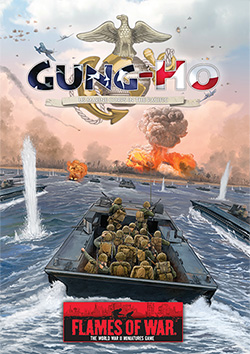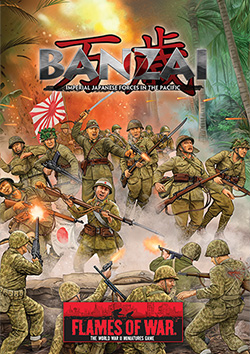The Pacific
At long last, Flames Of War enters a new theatre of operations, with the release in March of the first two Pacific briefings,
Gung-Ho and
Banzai.

 Gung-HoUS Marine Corps in the Pacific
Gung-HoUS Marine Corps in the PacificThe US Marine Corps has had a long and proud history as part of the
US armed forces, and the Pacific Campaign of 1941 to 1945 is perhaps its
finest hour.
During the course of the war the Marine Corps had expanded from two
brigades of about 18,000 Marines to six divisions, five air wings, and
various supporting arms to over 485,000 Marines.
They were the tip of the American spear during the Pacific campaign
conducting amphibious assaults from Guadalcanal in the Solomon Islands,
through the atolls of Marshall Islands, to Islands of the Marianas with
the invasions of Saipan, Tinian, and Guam. They prepared the way for the
assault on Japanese by taking the Japanese possessions of Iwo Jima and
Okinawa, facing fierce fanatical resistance from Japanese defenders in
some of the most savage fighting of the entire war.
 BanzaiImperial Japanese Forces in the Pacific
BanzaiImperial Japanese Forces in the PacificThe Japanese Imperial armed forces had been at war since 1931 in
China and Manchuria. Their war in the Pacific is just the next step in
asserting their leadership over the Asia-Pacific region. In a series and
well-planned and executed campaigns in late-1941 and 1942 veteran
Japanese forces quickly asserted their dominance in southeast Asia and
the western Pacific, toppling the western colonial powers and taking
control of these resource rich regions for the greater good of the
Japanese Empire.
However, the Japanese strike on Pearl Harbor has woken the Americans.
The Japanese must fight with determination to hold their gains, to push
the westerners back, and consolidate Japanese control.
Each inch of ground is not given lightly, with each beach, hill,
village, island, and airfield defended and counter-attacked with a
ferocity and spirit of will that no enemy can stand against.
